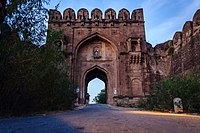
Photo from wikipedia
In this study, we assess the drinking water quality of Jhelum city. Two hundred and ninety-two drinking water samples were randomly collected in the study area. These samples were chemically… Click to show full abstract
In this study, we assess the drinking water quality of Jhelum city. Two hundred and ninety-two drinking water samples were randomly collected in the study area. These samples were chemically analyzed for three key toxic (in excess) elements such as pH, total dissolved solids (TDS), and calcium. Geostatistical techniques such as variogram and kriging were used to investigate the spatial variations of these minerals across the city. The spatial structure for each element was found to be anisotropic, and thus, anisotropic variograms were used. The kriging predictions revealed significant concentrations of the above-stated elements at some locations in the study area. While comparing with the World Health Organization, United States Environmental Protection Agency, and Pakistan Environmental Protection Agency standards, the water samples were found to be unsatisfactory for drinking. We conclude that the drinking water in this region is of poor quality and needs proper treatment to make it palatable.
Journal Title: Environmental Monitoring and Assessment
Year Published: 2017
Link to full text (if available)
Share on Social Media: Sign Up to like & get
recommendations!